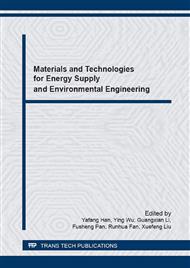[1]
Yu Huaqing. Life cycle assessment of electrolytic nickel production. Kunming University of Science and Technology, (2006).
Google Scholar
[2]
Sakai T, Yoshinaga H, Miyamura H, et al. Rechargeable hydrogen batteries using rare-earth-based hydrogen storage alloys. Journal of alloys and compounds, 180 (1992) 37-54.
DOI: 10.1016/0925-8388(92)90361-c
Google Scholar
[3]
Lascelles K, Morgan L G, Nicholls D. Nickel compounds. Ullmann's Encyclopedia of Industrial Chemistry, (2005).
Google Scholar
[4]
Wang Shoubing, Yang Jianxing. Life cycle assessment method and progress. Shanghai environmental science, 17 (1998) 7-10.
Google Scholar
[5]
Fan Qingxing, Ao Hongguang, Meng Chao. Life cycle assessment. Environmental science and management, 32 (2007) 177-180.
Google Scholar
[6]
Sun Qihong, Wan Nianqing, Fan Yuhua. Life cycle assessment (LCA) study of abroad. World standardization and quality management, 12(2000) 24-26.
Google Scholar
[7]
Matheys J, Timmermans J M, Van Mierlo J, et al. Comparison of the environmental impact of five electric vehicle battery technologies using LCA. International Journal of sustainable manufacturing, 1 (2009) 318-329.
DOI: 10.1504/ijsm.2009.023977
Google Scholar
[8]
Schexnayder S M, Das S, Dhingra R, et al. Environmental evaluation of new generation vehicles and vehicle components. Engineering Science and Technology Division, Oak Ridge National Lab., US Dept. of Energy, Oak Ridge, Tennessee, (2001).
DOI: 10.2172/768256
Google Scholar
[9]
Majeau-Bettez G, Hawkins T R, Strømman A H. Life cycle environmental assessment of lithium-ion and nickel metal hydride batteries for plug-in hybrid and battery electric vehicles. Environmental science & technology, 45 (2011) 4548-4554.
DOI: 10.1021/es103607c
Google Scholar
[10]
Zhang Hong, Li Jing, Wang Jun. Local development and application of life cycle assessment. North Environment, 9 (2011) 33-33.
Google Scholar
[11]
Zhou Zupeng, Jiang Zhansi. Gap analysis of life cycle assessment between domestic and abroad. Combination machine tools and automatic processing technology, 1 (2013) 12-13.
Google Scholar
[12]
Bai Lu, Sun Qihong, Qiao Qi. Review of life cycle assessment development progress. Journal of Anhui Agricultural Sciences, 5 (2010) 2553-2555.
Google Scholar
[13]
Dunn J B, Gaines L, Barnes M, et al. Material and energy flows in the materials production, assembly, and end-of-life stages of the automotive lithium-ion battery life cycle. Argonne National Laboratory (ANL), (2012).
DOI: 10.2172/1044525
Google Scholar
[14]
Intergovernmental Panel on Climate Change (IPCC). IPCC Fourth Assessment Report: Climate Change 2007. (2007).
DOI: 10.1017/cbo9780511721731.009
Google Scholar
[15]
P. Artaxo, T. Berntsen, R. Betts, D. W. Fahey, J. Haywood, & J. Lean, et al. Changes in Atmospheric Constituents and in Radiative Forcing. In Climate Change VOLUME 14, NUMBER 2, (2007).
Google Scholar
[16]
Matheys J, Van Autenboer W, Timmermans J M, et al. Influence of functional unit on the life cycle assessment of traction batteries. The International Journal of Life Cycle Assessment, 12 (2007) 191-196.
DOI: 10.1065/lca2007.04.322
Google Scholar
[17]
Wang Zhicheng. Electric vehicles and power battery. Journal of information science and technology, (1995) 1-7.
Google Scholar
[18]
Hu Xingguo. Power battery technology and application. Beijing: Mechanical Industry Publishing House, (2009).
Google Scholar
[19]
Li Yixia. Life cycle assessment of power battery. Beijing University of Technology, (2012).
Google Scholar
[20]
Zackrisson M, Avellán L, Orlenius J. Life cycle assessment of lithium-ion batteries for plug-in hybrid electric vehicles–Critical issues. Journal of Cleaner Production, 18 (2010) 1519-1529.
DOI: 10.1016/j.jclepro.2010.06.004
Google Scholar
[21]
Notter D A, Gauch M, Widmer R, et al. Contribution of Li-ion batteries to the environmental impact of electric vehicles. Environmental science & technology, 44 (2010) 6550-6556.
DOI: 10.1021/es903729a
Google Scholar
[22]
China power yearbook editing committee. China power yearbook 2013. Beijing: China power press, (2013).
Google Scholar


